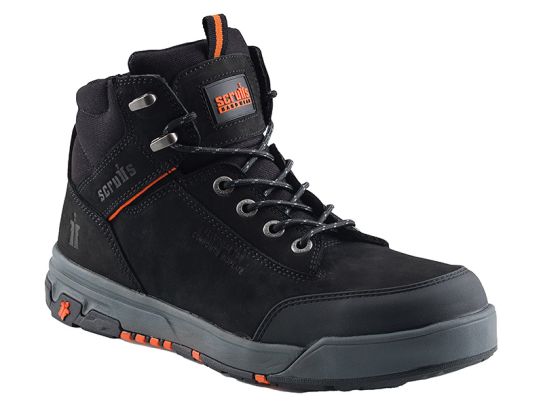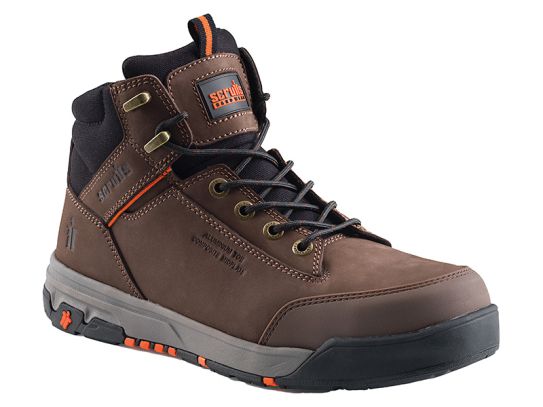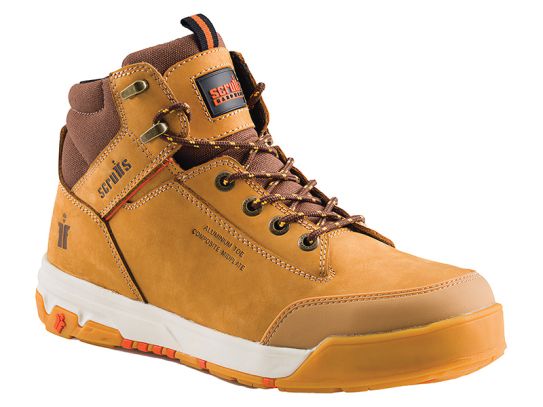Protective Footwear
Our safety boots are designed to keep you safe on the job. With steel toe caps and reinforced soles, these boots can protect your feet from falling objects and slips. Waterproof and slip-resistant outsole, means you will stay dry and safe in wet conditions.
Be Prepared for Anything With Our Protective Footwear
Introducing our top-of-the-line range of protective footwear, made to keep you safe and comfortable on the job. Whether you're working on a construction site, out in the elements, or dealing with heavy machinery, our selection of safety boots, waterproof wellington boots, and rigger boots has you covered.
Our boots boast steel toe caps, ensuring that your feet are protected from heavy falling objects. Whether you're looking for a low-cut style for improved mobility or a high boot for extra support, we've got you covered.
With our range, you can work with peace of mind, knowing that your feet are protected. The waterproof Wellington boots will keep you dry in wet conditions, the rigger boots feature a durable design that can withstand harsh working conditions and our Safety boots are built to meet or exceed ASTM standards to help protect your feet on the job.
Get ready to take on the toughest working conditions with confidence, knowing that our protective footwear has got your back. Upgrade your work gear today and experience the difference quality footwear can make!
What Is Protective Footwear?
Protective footwear is a type of footwear that is specifically designed to protect the feet from hazards that may be present in the workplace. This can include things like falling objects, electrical hazards, slips, trips, and falls, and exposure to chemicals or other hazardous materials. These hazards can cause serious injuries to the feet and toes, so protective footwear is essential for people who work in certain industries.
Protective footwear typically includes features like steel or composite toe caps, slip-resistant soles, and waterproof or water-resistant materials. They often meet specific safety standards like ASTM or OSHA, also they may also be reinforced in key areas, such as the heel and sole, to provide added protection and durability.
What Are Some Common Uses for Protective Footwear?
Protective footwear is used in a variety of industries and settings where there are potential hazards to the feet and toes. Some of the most common uses for protective footwear include:
- Construction: Workers on construction sites are at risk of falling objects, electrical hazards, and other dangers, so they often wear protective footwear with steel or composite toe caps.
- Manufacturing: Workers in manufacturing facilities may be exposed to heavy machinery, sharp objects, and other hazards, so they often wear protective footwear with reinforced toes and slip-resistant soles.
- Transportation and warehousing: Workers in these industries may be required to do a lot of walking and standing, and may be at risk of slips, trips, and falls. They often wear protective footwear with slip-resistant soles.
- Emergency Services: Emergency responders like firefighting or paramedics may wear protective footwear with steel or composite toe caps and slip-resistant soles to protect them from falling debris or potential electrical hazards.
- Food Service : Kitchen workers or chefs are required to wear slip-resistant shoes to reduce the risk of slips and falls on wet or greasy kitchen floors.
- Agriculture: Farmers and other agricultural workers may wear protective footwear to protect their feet from hazards like sharp objects, heavy machinery, and exposure to chemicals.
- Oil and Gas Industry: Workers in the oil and gas industry wear protective footwear that meets specific safety standards and can protect their feet from the hazards such as heat and fire.
These are just a few examples, but protective footwear is used in a wide variety of industries and settings to help protect workers' feet and toes from potential hazards.
What Are the Different Types of Protective Footwear?
There are several different types of protective footwear, each designed to meet specific needs and protect against different hazards. Some of the most common types include:
- Safety boots: Safety boots are a type of protective footwear that typically have steel or composite toe caps to protect the feet from falling objects, electrical hazards, and other dangers. They often also have reinforced soles and slip-resistant outsoles to protect against slips, trips and falls. They also can be waterproof or fire resistant.
- Work boots: Work boots are similar to safety boots, but may not have as many safety features. They are designed to be durable and comfortable for people who spend long hours on their feet.
- Wellington boots: Wellington boots, also known as rubber boots or rain boots, are made from waterproof materials to protect the feet from wet conditions. They often have slip-resistant soles and they can be used in different industries.
- Rigger boots: Rigger boots are a type of work boot that feature additional reinforcement in key areas, such as the heel and sole, to provide added protection and durability. They are commonly used in construction, oil and gas industry, and other heavy-duty industries.
- High-Visibility Footwear: This type of footwear is designed for workers in the transportation, construction, and emergency service industries, it features high-visibility colours and reflective materials for increased visibility in low-light conditions.
These are just a few examples of the different types of protective footwear available. The specific type of footwear needed will depend on the hazards present in the workplace, as well as the specific requirements of the job.
What Are the Key Features to Consider When Choosing Protective Footwear?
When choosing protective footwear, there are several key features to consider in order to ensure that the shoes provide the necessary level of protection for the specific hazards present in the workplace. Some of the most important features to consider include:
- Toe protection: Look for shoes with steel or composite toe caps to protect the feet from falling objects, electrical hazards, and other dangers. Some jobs have specific standards like ASTM or OSHA that dictate the minimum level of toe protection that is required.
- Slip-resistant soles: Slip-resistant soles can help to reduce the risk of slips, trips, and falls on wet or slippery surfaces.
- Waterproofing or water resistance: If the workplace is prone to wet conditions or exposure to chemicals, waterproof or water-resistant shoes can help to keep feet dry and comfortable.
- Reinforced Heel and Sole: This can help protect the feet from hazards such as falling objects, sharp objects, and heavy machinery, which can cause punctures or abrasions.
- Comfort: Look for shoes with a comfortable fit and support, to help prevent discomfort and fatigue while on the job. A good quality sole and insoles can help improve cushioning and support.
- High-Visibility: If you work in low-light conditions or around moving vehicles or heavy equipment, high-visibility shoes can help keep you safe by making you more visible to others.
- Specialty Footwear: For certain industries such as food service, healthcare or laboratory, shoes with specific characteristics such as being easy to clean or to prevent contamination may be necessary.
- Compliance: Make sure that the shoes you choose meet any applicable safety standards and regulations for your industry.
Ultimately, the specific features you need in your protective footwear will depend on the hazards present in your workplace, so it's important to carefully consider what you need to protect against.
What Type of Toe Protection Is Best?
When it comes to toe protection in protective footwear, both steel and composite toe caps are popular options. The type of toe protection that is best for you will depend on a number of factors, including the specific hazards present in your workplace, as well as your personal preferences.
- Steel toe caps are the most traditional type of toe protection and offer the highest level of protection from falling objects and other hazards. They are made of steel and are typically heavy-duty and durable, steel toe caps provide the most protection to the toes.
- Composite toe caps, on the other hand, are made of a combination of materials such as plastic, carbon fibre, or Kevlar. They are lightweight and can be more comfortable for some people. They also do not conduct heat or cold, making them a suitable option for workers who work in temperature-controlled environments or in cold temperatures. They also don't set off metal detectors, which is important for some industries or workplaces.
Ultimately, the choice between steel and composite toe caps will depend on your specific needs and preferences. It's important to consider the hazards present in your workplace, as well as the comfort and fit of the shoes, when choosing the right type of toe protection for you.
How Long Will My Protective Footwear Last?
The lifespan of your protective footwear will depend on a variety of factors, including the frequency of use, the type of job and the care you give to the shoes.
- If you are using your shoes on a daily basis or in harsh conditions, they will likely need to be replaced more frequently than shoes that are used infrequently or in less demanding conditions. A rough estimate could be up to 6 months to a year, but it really depends on the usage and care.
- It's important to monitor the condition of your shoes regularly, and to replace them when they show signs of wear and tear. Some signs that your shoes need to be replaced include holes in the uppers, worn or missing laces, worn-out soles, or holes in the soles. Shoes that are worn out or don't fit properly can cause discomfort and fatigue and can also increase the risk of accidents and injuries.
- In addition to keeping an eye on the wear and tear of your shoes, it's also important to take good care of them to help extend their lifespan. This may include regular cleaning and conditioning, storing them in a cool, dry place when they're not in use, and protecting them from excessive heat or moisture.
- If you're looking to extend the life of your shoes as much as possible, some maintenance tricks that may help you to achieve this, such as periodically re-applying waterproofing agents, or rotating your shoes with other pairs, so that they have a chance to dry and air out between uses.
It's also important to note that when you purchase shoes, it's important to choose a reputable brand and to follow the manufacturer's care instructions. Higher quality shoes will typically last longer than cheaper, lower quality options.
What Safety Considerations Should Be Taken Into Account When Using Protective Footwear?
When using protective footwear, there are several safety considerations to keep in mind in order to ensure that the shoes provide the necessary level of protection for the specific hazards present in the workplace. Some of the most important considerations include:
- Proper fit: Make sure that the shoes fit properly and are comfortable to wear. Shoes that are too tight or too loose can cause discomfort and fatigue, and may also increase the risk of accidents and injuries.
- Proper usage: Use the shoes for the purposes they are designed for, and in the environments for which they are intended. Misusing or overusing the shoes can cause them to wear out more quickly, and may also decrease their effectiveness in protecting the feet.
- Maintenance: Regularly inspect and maintain the shoes, including cleaning and conditioning them, to ensure that they remain in good condition and continue to provide the necessary level of protection.
- Replace worn out shoes: Replace shoes that show signs of wear and tear, such as holes in the uppers, worn or missing laces, worn-out soles, or holes in the soles.
- Training: Employees should be trained on the proper use and care of the protective footwear, and on the hazards present in the workplace that the footwear is designed to protect against.
- Proper use of additional PPE: Protective footwear is only one part of PPE, other equipment such as gloves, goggles, or respirators might be needed. Make sure that the employees are wearing all the necessary PPE to provide complete protection.
It's important to remember that protective footwear is a necessary part of any safety program and is one of the best ways to reduce injuries from the hazards present in the workplace. By following these safety considerations, you can ensure that the footwear you use is effective in protecting your feet and toes, and help to reduce the risk of accidents and injuries.
Are There Any UK or European Industry Standards or Regulations That Apply to Protective Footwear?
Yes, there are several UK and European standards and regulations that apply to protective footwear, to help ensure that the shoes provide the necessary level of protection for the specific hazards present in the workplace. Some of the most important standards include:
- The Personal Protective Equipment Regulations (PPE) 1992: These regulations state that employers have a duty to provide and maintain safe and healthy working conditions. The regulations also require that PPE must be CE marked, which means it complies with EU standards and is fit for purpose.
- The British Standard BS EN ISO 20345:2011 - Safety Footwear: This standard provides specific requirements for safety footwear and is intended to protect the feet against a range of hazards such as falling objects, slips, trips, and electrical hazards.
- The European Standard EN ISO 20345:2011 - Personal protective equipment - Safety footwear: This is an equivalent standard of the British Standard and has the same requirements.
- The European Standard EN ISO 20347:2012 - Personal protective equipment - Occupational footwear: This standard is intended for occupational footwear that is not safety footwear, but it is designed to protect the feet against slips, trips and abrasions.
- The British Standard BS EN ISO 20347:2012 - Occupational footwear: Similar to the European standard and has the same requirements.
These standards provide a framework for the design, testing, and manufacture of protective footwear, and are intended to ensure that the shoes are safe and effective in protecting the feet and toes from the hazards present in the workplace.
It's important to note that when purchasing protective footwear, to ensure that it meets the appropriate UK or EU standard, as well as any industry-specific requirements. This is done by checking for the CE mark, which verifies that the product has been tested and conforms to the relevant safety standards.


